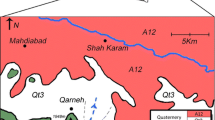Abstract
Bailong Cave with its well-developed Middle Triassic calcareous dolomite’s system was opened as a show cave for visitors in 1988. The speleothem scenery has been strongly weathered as white powder on the outer layers. Study of the cave winds, permeability of soil-rock system and the chemical compositions of the dripping water indicated: (1) The cave dimension structure distinctively affects the cave winds, which were stronger at narrow places. (2) Based on the different soil grain size distribution, clay was the highest in composition in the soil. The response sense of dripping water to the rainwater percolation was slow. The density of joints and other openings in dolomite make the dolomite as mesh seepage body forming piles of thin and high columns and stalactites. (3) Study of 9 dripping water samples by HYDROWIN computer program showed that the major mineral in the water was dolomite.
Similar content being viewed by others
References
Baker, A., Genty, D., 1998. Environmental pressures on conserving cave speleothems: Effects of changing surface land use and increased cave tourism.Journal of Environmental Managemnet,53:165–175.
Bögli, A., 1978. Karst Hydrology and Physical Speleology. Springer, New York, p. 156–200.
Cigna, A.A., 1993. Environmental management of tourist caves.Environmental Geology,21:173–180.
Craven, S.A., 1996. Carbon dioxide variations in Cango Cave, South Africa.Cave and Karst Science,23:89–92.
Dragovich, D., Grose, J., 1980. Impact of tourists on carbon dioxide levels at Jenolan Caves, Australia: an examination of microclimatic constraints on tourist cave development.Geoforum,21:111–120.
HPBG (Hebei Provincial Bureau of Geology), 1978. Hydrogeology Manual. Geological Publishing House, Beijing, p.22–56.
Huppert, G., Burri, E., Forti, P., Cigna, A.A., 1993. Effects of tourist development on caves and karst.Catena Special Supplement, p.251–268.
Villar, E., Fernandez, P.L., Guiterrez, I., Quindos, L.S., Soto, J., 1986. Influence of visitors on carbon concentrations in Altamira.Cave Science,13:21–23.
Author information
Authors and Affiliations
Corresponding author
Additional information
Project (Nos. 90202017 & 40071017) supported by the National Natural Science Foundation of China
Rights and permissions
About this article
Cite this article
Wang, J., Song, Lh. Effect of soil-rock system on speleothems weathering in Bailong Cave, Yunnan Province, China. J Zheijang Univ Sci B 6, 202–207 (2005). https://doi.org/10.1631/jzus.2005.B0202
Received:
Accepted:
Published:
Issue Date:
DOI: https://doi.org/10.1631/jzus.2005.B0202




